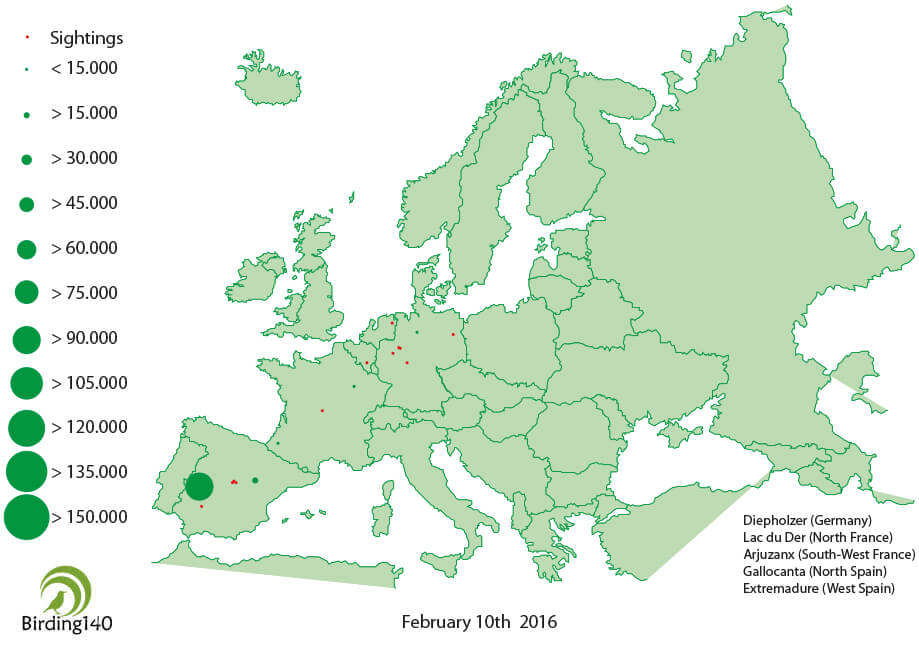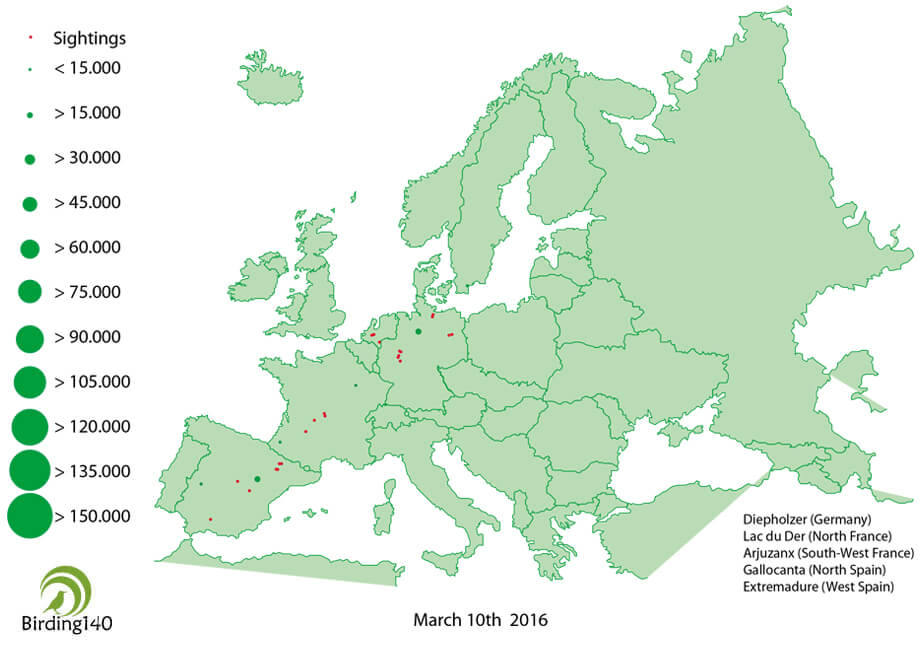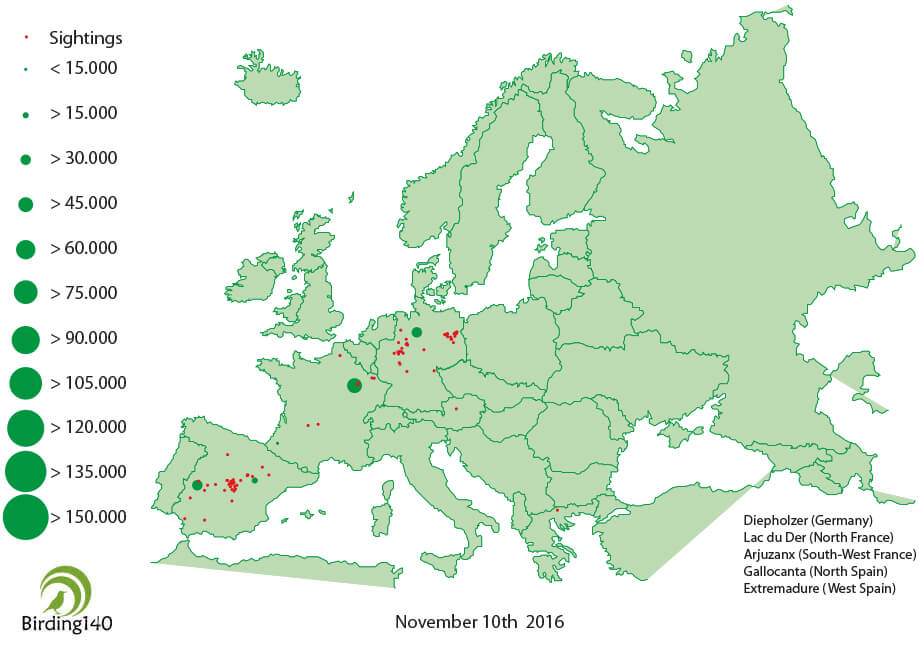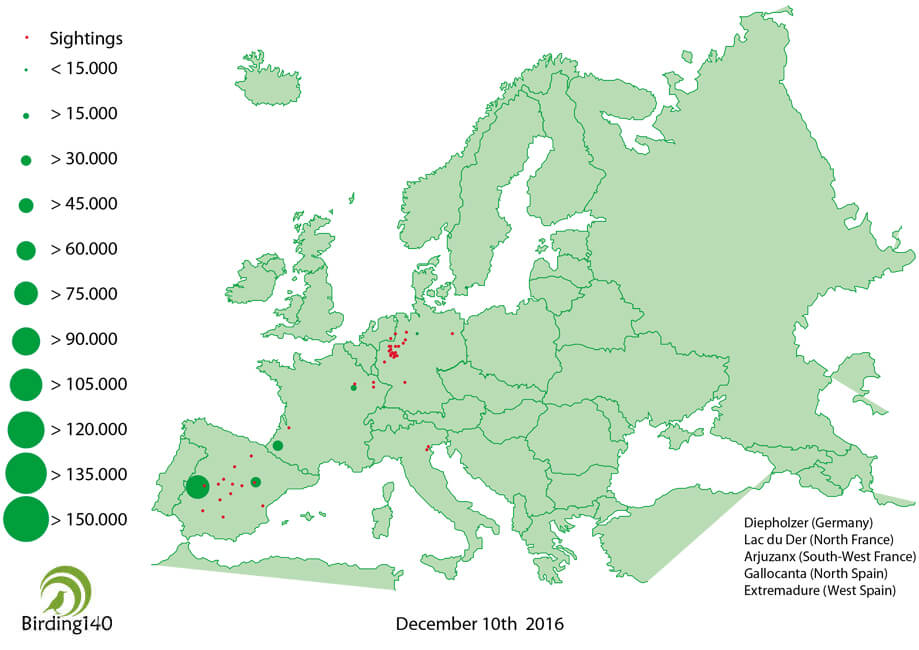We present our fourth tracking report about the migration of the Common Crane (Grus grus) around Europe. The analysed period covers a whole year, and we collect the tweets you have sent us from January to December 2016.
As in previous reports, we show the data in the form of maps. Each sighting is represented by a red dot, and we also place five green dots to indicate the number of cranes present at the end of the period to which each map refers in the following places: Diepholzer Moorniederung, Lac du Der, Arjuzanx, Gallocanta and the region of Extremadura.
Migratory maps of the Common Crane in Europe
Here is the first map. It reflects the situation as we left it on the previous report, on 10 January 2016. Most of the cranes that followed the western route are scattered on the centre and south of the Iberian Peninsula. Approximately half of them are concentrated in Extremadura, and only a few hundreds have crossed the Strait of Gibraltar in order to hibernate in Morocco.

Sightings of migration of cranes in Europe until January 10th 2016
We continue with the second map. It shows the sightings between 11 January and 10 February 2016, as well as the situation of the five reference places on this last day. As you can see, there seems to be no changes: the cranes spend the winter calmly, without any large movement. However, we still receive sightings of small flocks in Germany and France, which proves that some cranes risk spending the winter in Central Europe.

Sightings of migration of cranes in Europe until February 10th 2016
Migration to the north
Although everything seems quiet, on 17 February starts a slow migration towards the northeast of the Iberian Peninsula. The weather is favourable, and the flocks stay a few hours resting on the surroundings of the lake of Gallocanta, their main concentration site before crossing the Pyrenees. They will shortly leave towards the north.
On 25 February, the Government of Aragon registers 60,090 cranes in Gallocanta, a smaller number than previous years. The censuses carried out by Grupo Ornitológico Oscense in the reservoir of La Sotonera are also lower than last year. These data seem to confirm that the cranes benefit from the days of favourable weather to cross the Pyrenees. Shortly after arriving to the northeast of the Peninsula, they face the journey to France. On 25 February there are already sightings of large flocks in the central area of France.

Sightings of migration of cranes in Europe until March 10th 2016
In the map of 10 March 2016 we can observe how the majority of the crane population in western Europe has abandoned the Iberian Peninsula and is on its way to the north; most of them are already in Germany. The migration to the north is about to end. The large flocks will soon disperse around the Scandinavian Peninsula and the coast of the Baltic sea.
The breeding season of the Common Crane
The Common Crane is a bird known for its loyalty. It usually stays with its first partner for its whole life. While it is sociable and gregarious during the migration and wintering, the Common Crane becomes just the opposite during the breeding season. Each couple settles on a swampy or marshy area of at least 200 hectares, where they don’t allow the presence of other cranes.
Early in the morning males and females can be observed jumping with their wings extended showing a majestic courtship dance. In May they will carry out the laying, usually two eggs, which they will incubate for four weeks. Crane chicks are nidifugous and they leave the nest a few hours after being born in order to walk with their parents.
In the following map we gather the sightings until 10 August 2016. The cranes remain scattered around the breeding areas, together with their chicks, which at this time are performing their first flights. When the chicks reach 4 or 5 kilogrammes of weight, the families will start to gather in order to begin their trip to the south.

Sightings of migration of cranes in Europe until August 10th 2016
The migration to the south starts
We continue with the map of 10 November 2016. Some of the great flocks have already arrived to the Iberian Peninsula. However, most of our cranes are on their way, resting in Germany and the north of France.
The first sighting of a flock crossing the Navarrese Pyrenees towards the south takes place on 20 September. Meanwhile, on the northeast of Germany over 50,000 cranes are already gathered. The following day 504 specimens are registered in Lac du Der. On 22 September the first ones arrive to Gallocanta, and on 7 October the first flock can be seen above Madrid on their way to Extremadura.
The first great crossing of the Pyrenees doesn’t arrive until 31 October; from 1 November small flocks of cranes cross Madrid almost constantly. Little by little, the Iberian Peninsula fills with cranes, although by 10 November most of the flocks are still in Germany and the south of France.

Sightings of migration of cranes in Europe until Novembrer 10th 2016
In the following map we observe the situation of 10 December. Most European cranes have already arrived to the Iberian Peninsula, and many of them are concentrated in the pastures of Extremadura. They have arrived just on time: the fruits of the holm oaks, the nutritive acorns they like so much, have just ripen and start falling to the floor.

Sightings of migration of cranes in Europe until December 10th 2016
In November 2014 we encouraged you to take part in a cooperative project to follow the migratory flows of the Common Crane in Europe. Today, two years after the experiment began, we are feeling overwhelmed by the high number of people who still want to collaborate. We want to thank all our friends from Norway, Sweden, Finland, Latvia, Germany, Netherlands, Belgium, France, Italy, Malta, Greece and Spain for all of your sightings and comments. THANK YOU!

Family of cranes in Extremadura











